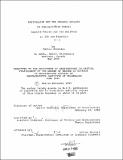| dc.contributor.advisor | Stanford Anderson. | en_US |
| dc.contributor.author | Bressani, Martin | en_US |
| dc.contributor.other | Massachusetts Institute of Technology. Dept. of Architecture. | en_US |
| dc.date.accessioned | 2012-07-02T15:22:24Z | |
| dc.date.available | 2012-07-02T15:22:24Z | |
| dc.date.copyright | 1985 | en_US |
| dc.date.issued | 1985 | en_US |
| dc.identifier.uri | http://hdl.handle.net/1721.1/71370 | |
| dc.description | Thesis (M.S.)--Massachusetts Institute of Technology, Dept. of Architecture, 1985. | en_US |
| dc.description | MICROFICHE COPY AVAILABLE IN ARCHIVES AND ROTCH. | en_US |
| dc.description | Includes bibliographical references (leaves 283-301). | en_US |
| dc.description.abstract | The thesis studies the apartment block at 25b rue Franklin in Paris designed in 1903 by the architect Auguste Perret. It documents the building's history and discusses its design in the context of late-nineteenth-century theoretical debate on housing and architecture. The first part of the study examines the context. It includes an analysis of the ·various constraints that Perret faced at rue Franklin in an attempt to establish clearly the extent of their influence on the design of the building. ~ext a typological survey of the apartment block in nineteenth-century Paris brings out those aspects of the building type considered problematical by the architects of the period. The second part of the study discusses the theoretical issue of rationalism. It first distinguishes the different brands of rationalist theories in France at the end of the nineteenth century. An examination of the 25b shows the mark left by the writings of Eugene Viollet-le-Duc on Perret's rationalist conceptions of architecture. It also illustrates the link established between industry and rationalism at rue Franklin. The third section of the thesis addresses the organic theory of architecture in its relation to the 25b rue Franklin. Contrary to the conventional view, the discussion demonstrates that the design of 25b rue Franklin entailed aims which went beyond a strict response to legal or site constraints or the faithful expression of structure. Perret at rue Franklin attempted to root his architecture in society, nature, and history. This "organicism" was again largely indebted to the insights of Viollet-le-Duc. It also reflected Perret's firm conviction that reinforced concrete itself was an "organic" material which summarized and surpassed all previous materials. With such notions in mind, Perret endeavored to achieve a synthesis of what were considered the two great architectural traditions of the Western world: Gothic and Greek. | en_US |
| dc.description.statementofresponsibility | by Martin Bressani. | en_US |
| dc.format.extent | 2 v. (396 leaves) | en_US |
| dc.language.iso | eng | en_US |
| dc.publisher | Massachusetts Institute of Technology | en_US |
| dc.rights | M.I.T. theses are protected by
copyright. They may be viewed from this source for any purpose, but
reproduction or distribution in any format is prohibited without written
permission. See provided URL for inquiries about permission. | en_US |
| dc.rights.uri | http://dspace.mit.edu/handle/1721.1/7582 | en_US |
| dc.subject | Architecture. | en_US |
| dc.title | Rationalism and the organic analogy in fin-de-siècle Paris : Auguste Perret and the building at 25b rue Franklin | en_US |
| dc.title.alternative | Problems of housing, technology, and building form in fin de siecle Paris : Auguste Perret and the building at 25b rue Franklin | en_US |
| dc.type | Thesis | en_US |
| dc.description.degree | M.S. | en_US |
| dc.contributor.department | Massachusetts Institute of Technology. Department of Architecture | |
| dc.identifier.oclc | 14771093 | en_US |
